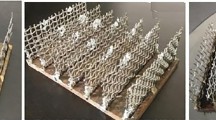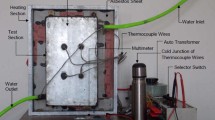Abstract
This paper presents an approach for the multi-objective optimization of the flat plate heat sink using Taguchi design of experiments-based Grey relational analysis. The responses studied were electromagnetic emitted radiation, thermal resistance, average heat transfer coefficient, pressure drop, and the mass of the flat plate heat sink. The heat sink is modeled using Ansoft High Frequency Structure Simulator (HFSS) software version 12 and the value of the emitted radiation is obtained by simulation. The same heat sink is modeled using Flotherm V7.2 software for finding the thermal resistance, pressure drop, and average heat transfer coefficient. Experimental investigation was performed to find the thermal resistance and emitted radiations from the heat sink and thus the simulation model was validated with the experimental results. The simulations were continued for the combinations generated by the L27 (6 factors, three levels) Taguchi’s design of experiments using Minitab software. The factors considered for optimization are the length and width of the heat sink, fin height, base height, number of fins, and fin thickness. The multi-objective optimization problem is then converted into single-objective optimization problem using Grey relational analysis and the optimum design settings of the heat sink geometry were obtained. Also, ANOVA test was carried out for finding out the contribution and impact of each heat sink design factor towards the multiple responses of the heat sink.
Similar content being viewed by others
References
Tummala R (2001) Fundamentals of microelectronic packaging. McGraw-Hill Professional
Shih CJ, Liu GC (2004) Optimal design methodology of plate-fin heat sinks for electronic cooling using entropy generation strategy, components and packaging technologies. IEEE Transactions 27(3):551–559
Teertstra P, Yovanovich MM, Culham JR, Lemczyk T (1999) Analytical forced convection modeling of plate fin heat sinks. in Proc. 15th IEEE SEMI-THERM Symp
Das R (1998) An investigation on radiated emissions from heat sink. IEEE Int Symp Electromagn Compat 2:784–789
Brench (1994) Heat sink radiation as a function of geometry. in proceedings. IEEE Symp, Electromoagnetic Compatibility 105–109
Parry J (2000) Multiphysics modeling for electronics design. Therm Thermo Phen Elect Sys, ITTHERM 2:86–93
Mohammad G, Mohammad TB (2008) “Multilevel converter objectives: a critical evaluation and combination of available natural commuted topologies with restructured iron cores”, Proceedings of world congress on Engineering and computer science WCEC 428–433
Georgerian R, Mantrose I (2003) Product safety and the heat sink—dilemma of minimizing radiated emissions and maximizing thermal cooling. IEEE Int Symp Electromagn Compat 1:134–137
Archambeault B, Pratapneni S, Zhang L, Wittwer DC, Chen J (2001) A proposed set of specific standard EMC problems to help engineers evaluate EMC modeling tools. IEEE Int Symp Electromagn Compat 2:1335–1340
Lu J, Xiao D (2007) Comparative analysis of Intel Pentium IV and IEEE/EMC TC-9/ACEM CPU heat sinks. IEEE International Symposium on Electromagnetic Compatibility 1–6
Lu J, Dawson F (2006) EMC computer modeling techniques for CPU heat sink simulation. IEEE Trans Magn 42(10):3171–3173
Sochoux P, Yu J, Bhobe A, Centola F (2008) Heat sink design flow for EMC. Design Con, IEC publications 1–27
Visser, JA, de Kock DJ, Conradie FD. Minimisation of heatsink mass using mathematical optimization. IEEE Semiconductor Thermal Measurement and Management Symposium 252–259s
Culham JR, Muzychka YS (2000) Optimization of plate fin heatsinks using entropy generation minimization. In Proc. IEEE Intersociety Conf. Thermal Phenomena
Shah A, Sammakia B, Srihari H (2002) A numerical study of the thermal performance of an impingement heatsink fin shape optimization. ITHERM 298–306
Khan WA, Yovanovich MM, Culham JR (2006) Optimization of microchannel heatsinks using entropy generation minimization method. IEEE International Conference on Semiconductor Thermal Measurement and Management Symposium 78–86
Bar-Cohen A, Rohsenow WM (1984) Thermally optimum spacing of vertical, natural convection cooled, parallel plates. J Heat Transfer 106:116–123
Bar-Cohen A (1992) State-of-the-art and trends in the thermal packaging of electronic equipment. J Electron Package 114:257–270
Kraus AD, Bar-Cohen A (1995) Design and analysis of heatsinks. Wiley, New York
Chen C-T, Wu C-K, Hwang C (2008) Optimal design and control of CPU heat sink processes, components and packaging technologies. IEEE Transactions 31(1):184–195
Lin CL (2004) Use of the Taguchi method and Grey relational analysis to optimize turning operations with multiple performance characteristics. Mater Manuf Process 19(2):209–220
Chiang K-T, Chang F-P, Tsai T-C (2006) Optimum design parameters of pin-fin heat sink using the grey-fuzzy logic based on the orthogonal arrays. Int Commun Heat Mass Transf 33:744–752
Chou C-C, Liu N-M, Horng J-T, Chiang K-T (2009) Designing parameter optimization of a parallel-plain fin heat sink using the grey-based fuzzy algorithm with the orthogonal arrays. Int J Therm Sci 48:2271–2279
Arularasan R, Velraj R (2008) Modeling and simulation of a parallel plate heat sink using computational fluid dynamics. Int J Adv Manuf Tech. doi:10.1007/s00170-008-1867-9
HFSS V12.0, Ansoft corporation http://www.ansoft.com/products/hf/hfss/
Flotherm - Fluent software tutorial available at www.fluent.com
Wakefield thermal compound datasheet available at http://www.wakefield.com/pdf/accessories.pdf
Anabond adhesive data sheet available at http://www.anabond.com/anabondImages/anabond.pdf
Douglas C. Montgomery, Design and analysis of experiments, Fifth edition. Wiley: New York. ISBN 9971-51-329-3
Minitab 15 software tutorial available at: http://www.minitab.com
Wang Z, Zhu L, Wu JH (1996) Grey relational analysis of correlation of errors in measurement. J Grey Syst 8(1):73–78
Author information
Authors and Affiliations
Corresponding author
Rights and permissions
About this article
Cite this article
Manivannan, S., Devi, S.P., Arumugam, R. et al. Multi-objective optimization of flat plate heat sink using Taguchi-based Grey relational analysis. Int J Adv Manuf Technol 52, 739–749 (2011). https://doi.org/10.1007/s00170-010-2754-8
Received:
Accepted:
Published:
Issue Date:
DOI: https://doi.org/10.1007/s00170-010-2754-8




